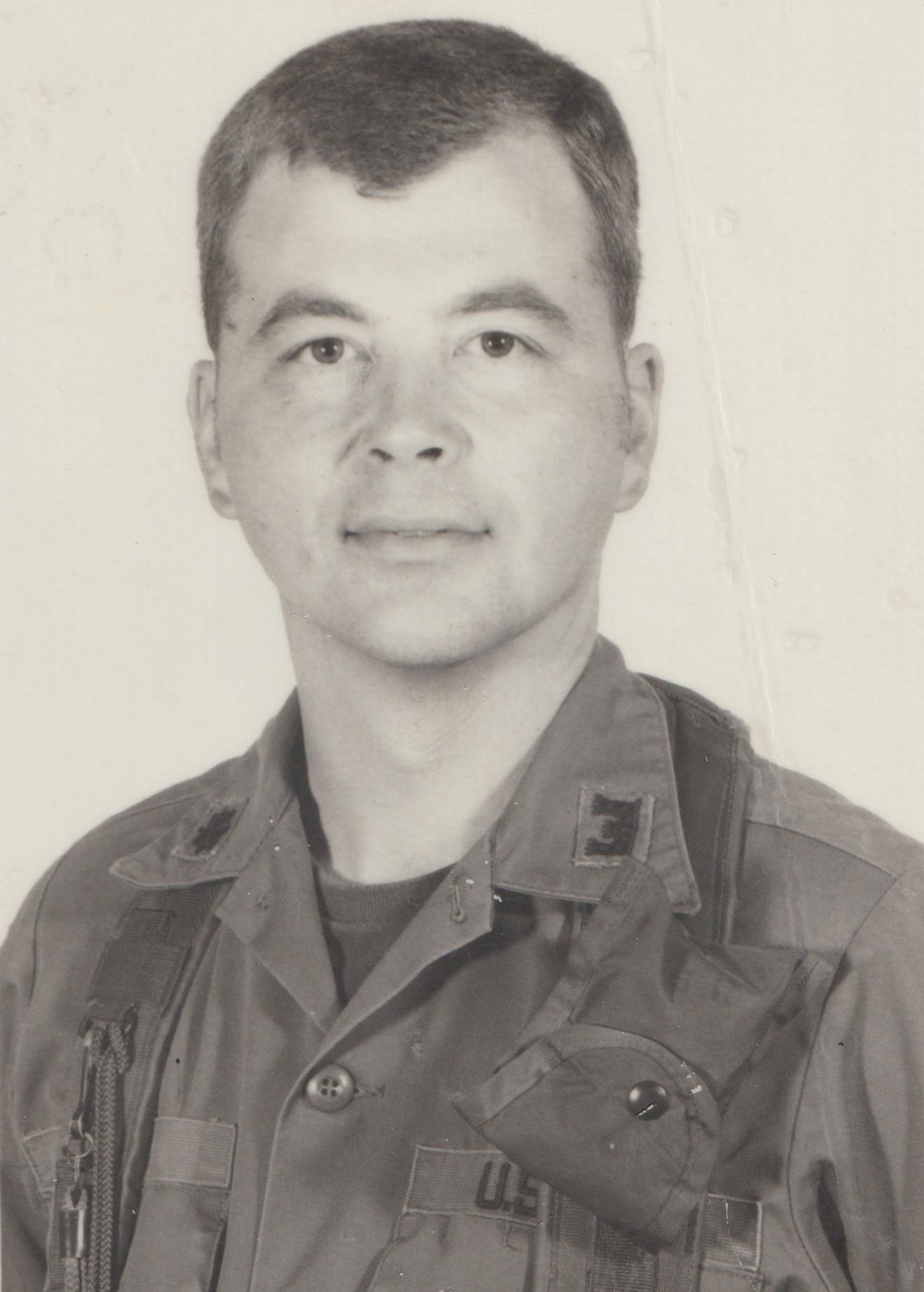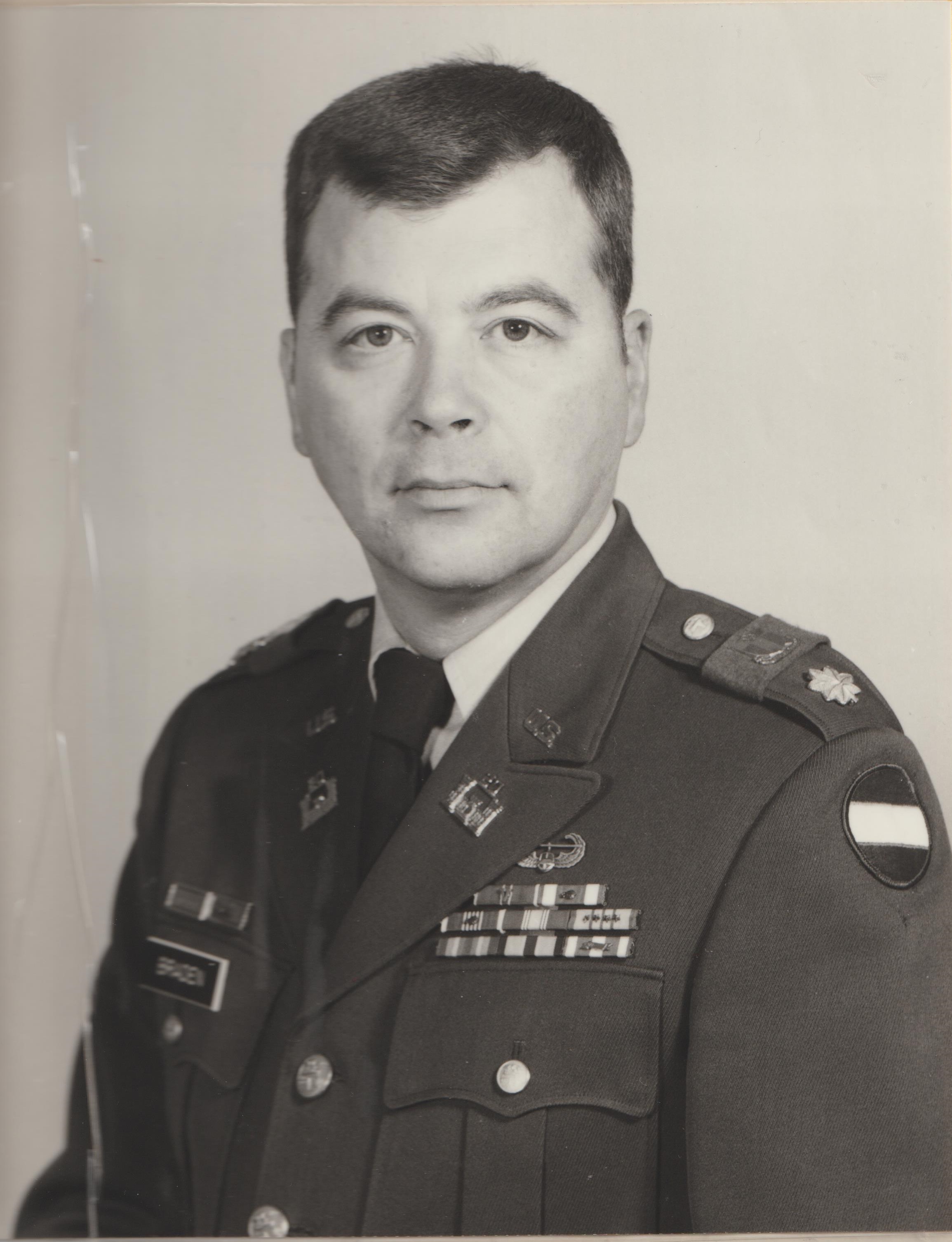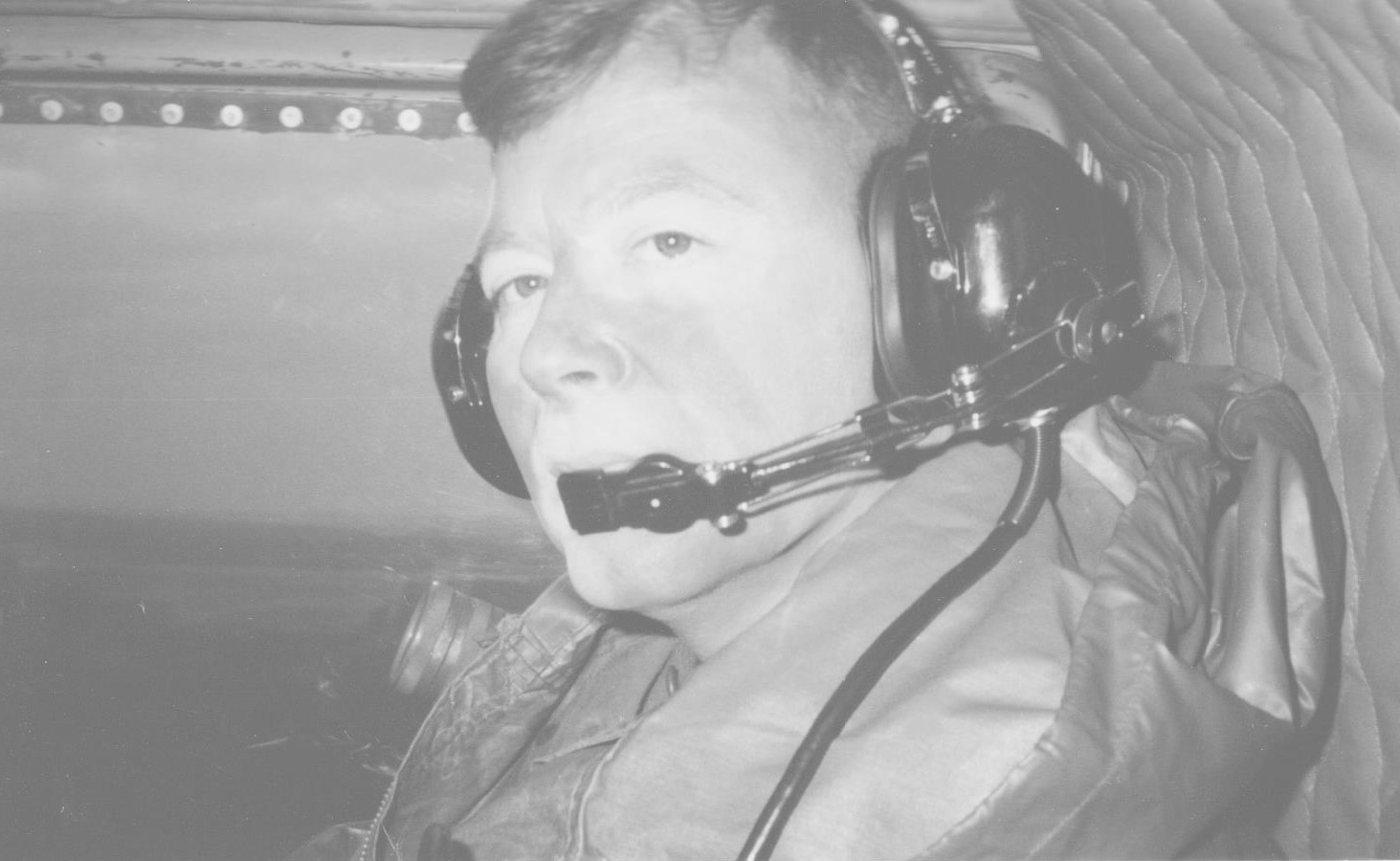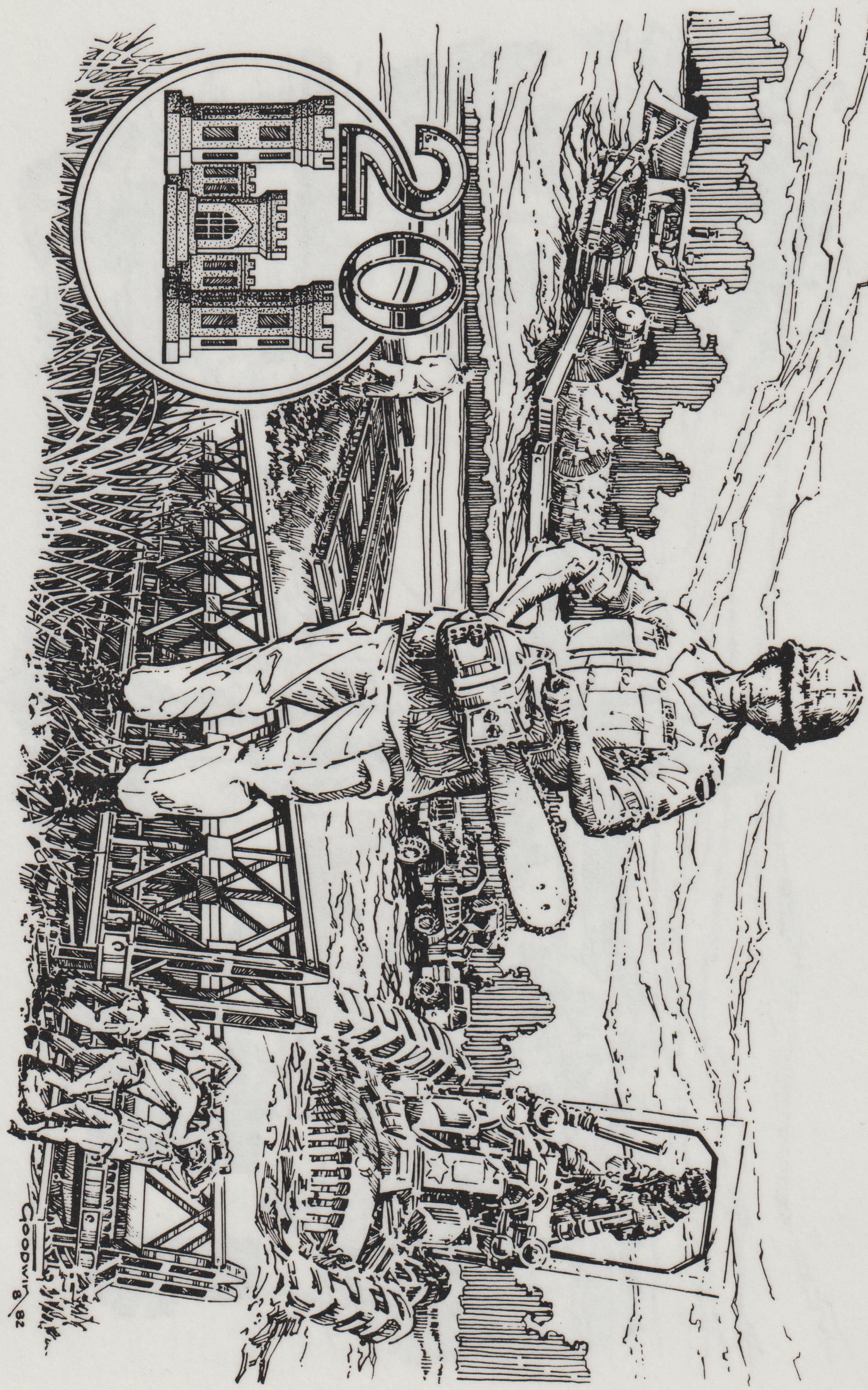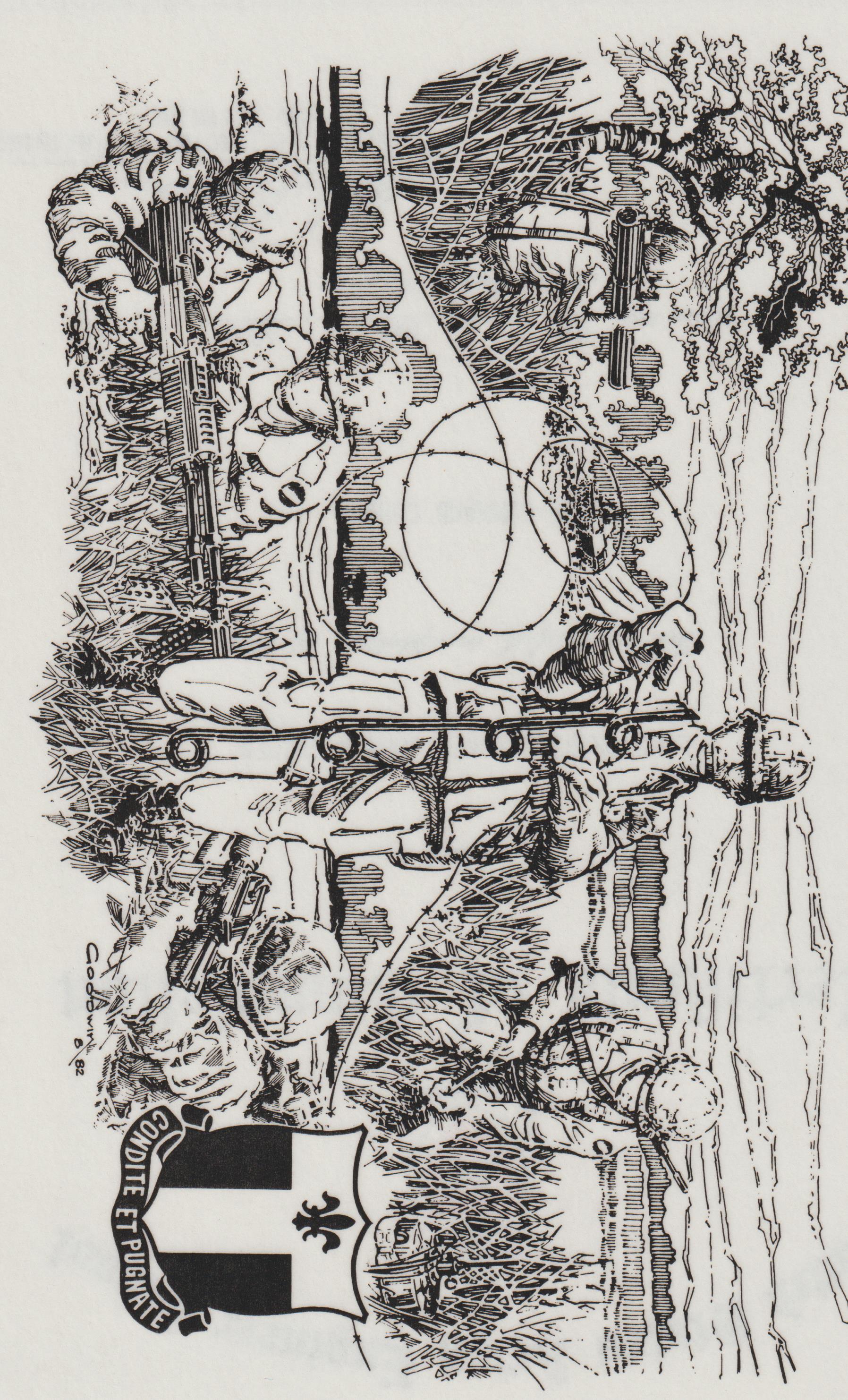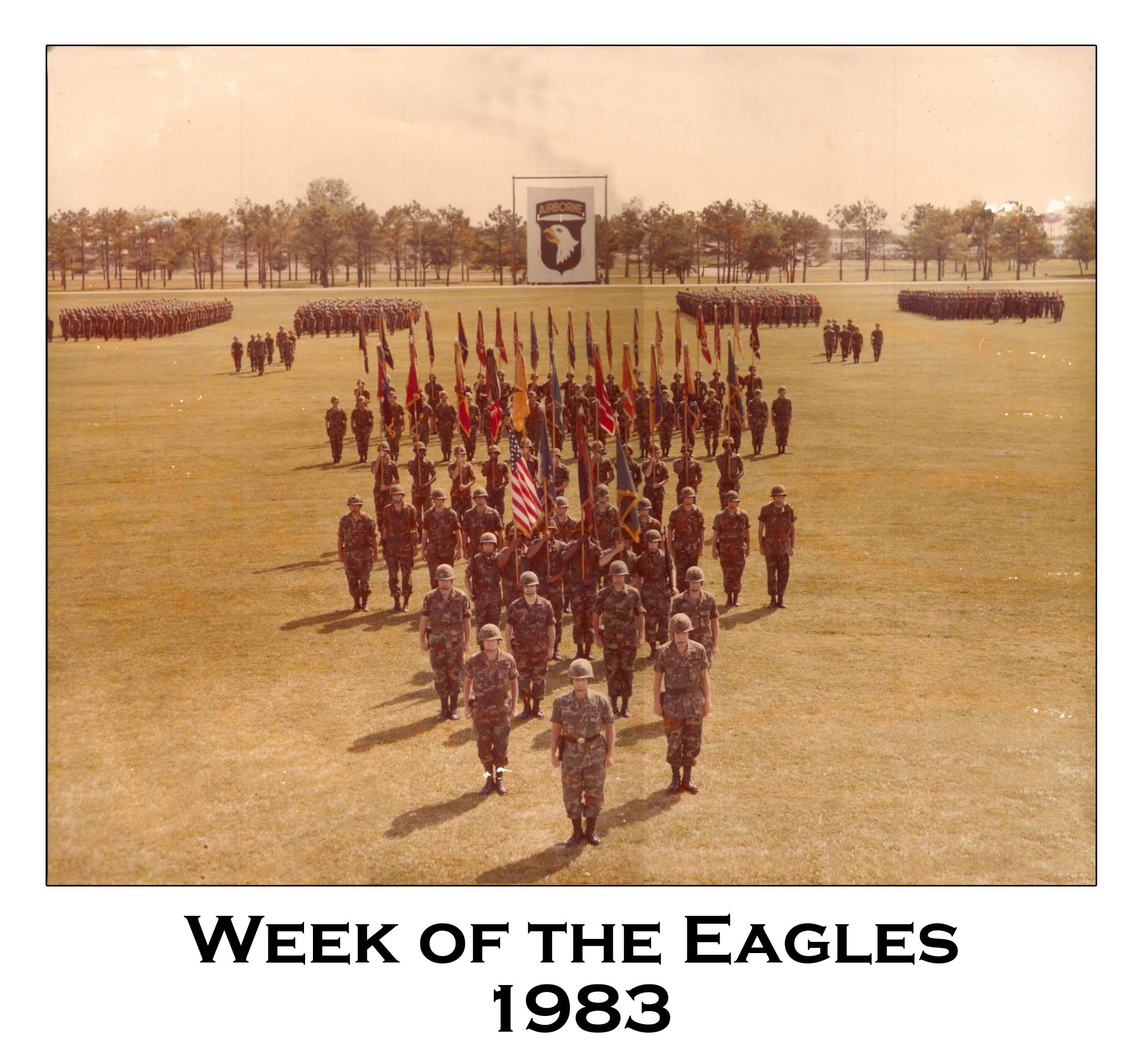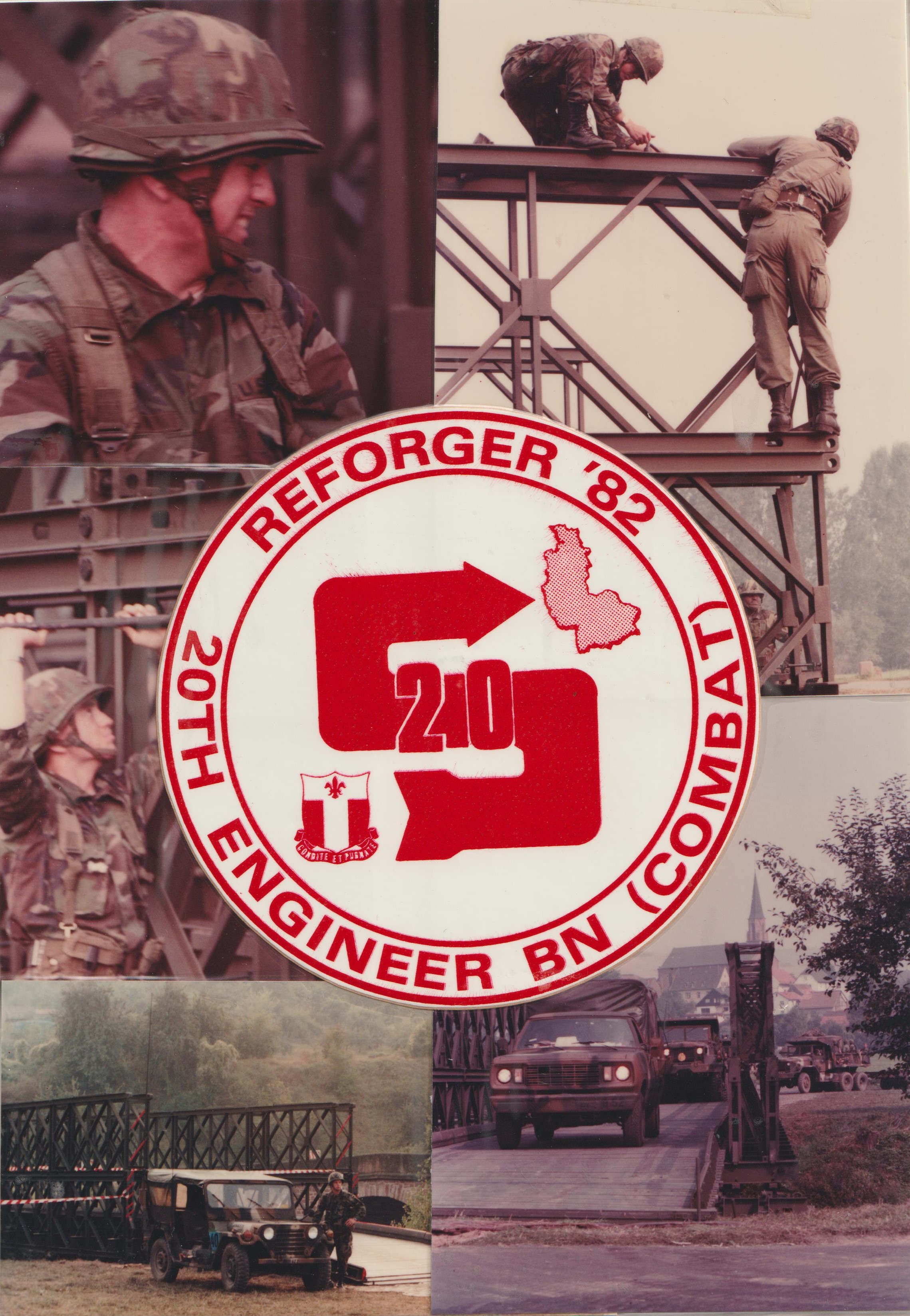
| These are some personal notes that describe some of my memories and opinions of the organizations that I served with in an Army career that spanned nearly 30 years. If you find this site by accident through a search engine you are welcome to contact me and share your thoughts. Thanks. My e-mail address is BradenClan@ gmail.com. |
|
20th Engineer Battalion (Combat)Fort Campbell, Kentucky 1981-1984
The 20th Engineer Battalion was a non-divisional combat engineer battalion assigned to Fort Campbell, Kentucky, home of the 101st Airborne Division (Air Assault).
In 1981 every Army division had its organic engineer battalion consisting of a headquarters company and four "line" companies; A, B, C, and D. Most divisions had three infantry or armor brigades so there were generally habitual relationships formed as in Company A of the divisional engineer battalion would support 1st Brigade, Company B would support 2nd Brigade, etc. Company D might be used to reinforce support to one of the brigades or to provide general support to other division organizations. But it was recognized that in wartime more engineers would be required to support the division than its organic battalion, so non-divisional engineers would be brought in to assist. (The best example of this is in the artillery, where sometimes ten or more non-divisional artillery battalions would be brought in to support a division's three artillery battalions.) The 20th Engineer Battalion, with about 620 soldiers, was organized similarly to the divisional battalion, but its equipment was heavier since it was not designed to be rapidly deployed by air.
When I arrived at Fort Campbell, it appeared that the battalion was considered a post support/construction asset for the post, and it was not especially well regarded.
To turn an engineer battalion into a good combat engineer battalion requires good training programs. I was able to use my knowledge of the training ammunition system and of how to obtain training areas - both mostly a matter of being able to do some long range projections - to set up some fairly realistic and rigorous battalion training exercises, from squad evaluations to platoon evaluations. To get out of the reputation of a post support unit and into the role of a combat engineer battalion, we arranged to be part of the field training every time one of the 101st brigades took to the training area. Since each brigade of the 101st had an "habitually related" company of divisional engineers,
The divisional engineer battalion was the 326th, commanded by Ed Starbird, whom I liked - personally. Professionally was somewhat of another story. Ed tried to influence the assignment process of engineer lieutenants coming into Fort Campbell so he got the cream of the crop. Ed or his predecessors also managed to funnel most of the training ammunition allocation to the 326th, which I found out about only after protesting my "shortage" of training ammunition and engineer explosives to Forces Command, who opened their books to the Fort Campbell allocations and opened my eyes to the rip off being conducted by the 326th. We fixed that in a meeting that went to the level of the Assistant Division Commander for Support, BG Gerald H. Bethke (a great soldier).
The battalion had some challenges beyond getting past its post support label. For example, the 20th had the most AWOL soldiers for the past year (84) of any of the 29 battalion-size units on the base. At Fort Campbell with the renowned 101st, any "other" unit was subject to being considered as substandard, and this was icing on that cake. To get out of the "Most AWOLs" category, I decided to meet with new soldiers twice a week, and did so for the next three years. In the sessions, conducted in my office, soldiers learned about the battalion's lineage and honors, to include being among the first to land in Normandy on D-Day in support of the 16th Infantry Regiment, 1st Infantry Division. They also learned the consequences of AWOL, and I gave out my home phone number, with the instructions to each soldier that if you find you cannot get back from leave or otherwise be at your appointed duties to give me a call. I explained that, without a call, I would not understand at all, and as the times came for discipline under Article 15 of the UCMJ, I indicated my lack of understanding via heavy punishments in terms of loss of rank, forfeiture of pay, restriction, and extra duties. Upon my departure three years later, we had had 4 AWOLs for the year, lowest at Fort Campbell in that category. (While punishments were part of the fixing the AWOL problem, I would like to think that the battalion soldiers came to understand they were part of a highly trained unit that was respected by the division it supported.)
The 20th Engineer Battalion also had a significant maintenance challenge. The battalion had very old M51 dump trucks as its primary vehicle and they were beyond their useful life span. Finding parts to keep them running was a constant challenge. Also, in each engineer platoon there were also over 50 sets, kits, and outfits that made accountability and repair a massive headache. I also found that our annual budget (mostly used for repair parts) was in the range of $360,000.
Warrant Officer Hunley, now a CW3 and formerly of the 370th Engineer Company, was a small miracle worker in the area of maintenance. Richard ultimately retired from the Army and is now retired from being a successful general contractor doing commercial construction in the area of Clarksville. Ginger, Richard, Bonnie and I remained very close friends. The world needs more of people like the Hunleys.
One other thing I did about half way through the command was to change how the battalion returned from a local field exercise. When the exercise was over, we didn't allow any vehicle back into the motor pool except those that were already clean. Clean vehicles are a lot easier to inspect than those caked with red Kentucky mud, so this was good ... but there was a scramble to find wash points around the post. The clean vehicles admitted into the motor pool were run through an inspection line so we could begin the maintenance process for those that required parts or repairs. I just told the NCO at the gate doing the cleanliness inspections that if dirty equipment got through then he would have to clean it. Worked like a charm.
More on maintenance. How do you keep an aging fleet running, especially when the requisition priority level is low (units in Germany, for example, had higher priority for parts than we did because they were "forward deployed")? Well, part of the answer is that you try to keep a lot of spare parts on hand. But that is bad for the Army and bad for the taxpayer. But try telling that to a company commander and a motor sergeant whose careers depend on keeping a high level of operational readiness. (Operational readiness means that the vehicles are running and not down for repairs.) So as much as we tried to make the system work, we knew in our hearts that we "had to" carry more parts than allowed by regulation. So what do you do when there is an upcoming IG inspection and you know you'll get written up for excess parts? One year, in preparation for the IG, we put three large containers dead center of the motor pool and told everyone that they could put their excess parts in them, no questions asked. Soon we had three 10' x 10' x 10' containers each about a foot and a half deep with excess parts. Just before the inspection, we locked all three. If the IG would have asked, "What's in those three large containers right in the middle of your motor pool?" we would have said, truthfully, that those were excess parts that we were in the process of categorizing and turning back into the system.
Still more . . .
A not-so-small note on the military’s Uniform Code of Military Justice (UCMJ), which addresses offenses that are punishable and maximum penalties for each type of offense; and it provides alternative methods to administer punishment. The system, to my knowledge, has been reviewed by numerous legal experts, and has found to be very fair. In good units, minor infractions by soldiers are handled by their sergeants, who do not use the military judicial system, but administer additional training. Additional training is supervised and the training is something that is related to soldier’s required job performance. Additional training, in itself, is not reflected on a soldier’s permanent record. Major offenses are referred to a trial by court martial. A conviction in a court martial results in a federal record for the soldier found guilty. There are three levels of court martial, depending on the severity of the offense. A General Court Martial is the highest level, and depending on the offense, can administer punishments that include dishonorable discharges, prison times, and for heinous crimes - a death sentence. There is also a level of punishment lower than a court martial that is administered by company level and field grade level commanding officers under the provisions of Article 15 of the UCMJ. Punishment under Article 15 is for relatively minor offenses, and can lead to reduction in rank, forfeiture of pay, extra duty, and restriction. A soldier who is offered the opportunity to accept an Article 15 procedure has the option to not accept that procedure but to demand a trial by court martial. Most soldiers, however, when offered an Article 15, accept that procedure, and they do have an opportunity to present matters in their defense and in extenuation and in mitigation. An Article 15 “conviction” is reflected on a soldier’s personnel file and is not helpful to the soldier when he or she is being considered for promotion and/ or retention. [As a side note, one of the brigades at Fort Campbell administered punishment by having guilty soldiers appear in full field gear: helmet, field pack, etc. but not weapons; and they were given a push mover to trim the grass in the brigade area.] With all that as a background, the question is who sits on the jury of a court martial? The answer is that a court martial board is assembled from a roster of personnel on the base that normally includes enlisted personnel of the rank sergeant major and commanders of battalions and brigades. At Fort Campbell my name soon rose to the top of the roster and I was called to serve on a board. The second time I was called was for a soldier who had stolen property in the barracks. The soldier had pleaded guilty in advance so the board had been assembled simply to learn about the case and then to prescribe an appropriate punishment. In military trials, and also in civilian trials, the prosecution and defense lawyers are given an opportunity before the procedure to question potential jury members to determine if they can, in fact, render a verdict based on the information provided in the proceedings, and not based on some prior preconceptions. This process is called voir dire (a preliminary examination of a witness or a juror by a judge or counsel of prospective jurors to determine their qualifications and suitability to serve on a jury, in order to ensure the selection of fair and impartial jury). During voir dire a lawyer for the prosecution or defense may ask a question of a specific juror or a general question to jurors and check for responses. In my case, the defense lawyer asked a general question to all jurors, and it went something like this: "Do any of you have any preconceived ideas about the soldier who has pleaded guilty to robbery?" All panel members except me shook their heads or otherwise indicated an answer of "no." Not me. I said, "Anyone who steals should not be in the Army." That immediately triggered a recess and I was shortly informed that thanks but my services were no longer required and I could return to my unit. As you might expect, the reply I provided during voir dire was probably circulated among the base's defense lawyers in a nanosecond, and I was never again called to serve on a court martial panel. But this bothered me. Each battalion at Fort Campbell had a prosecution lawyer who could be called for advice, so I called the lawyer who supported the 20th Engineer Battalion and said that I didn't make that statement to be kicked off the panel and never again invited to serve on a court martial board. He told me that defense attorneys asked a lot of leading questions like the one I had received during voir dire and a panel member should never take them too, too seriously. He said that, in the case of the question I answered, I might have considered in my mind the possibility that the soldier's father might have been a Medal of Honor winner and the soldier's grandfather was also a Medal of Honor winner and the soldier only stole something that have been taken from him after he had exhausted all legal matters to get the item back, so conceivably it might be possible for this soldier to steal something and not be discharged from the Army. He said to remember his "double Medal of Honor" story when answering future voir dire questions. Interesting. And I hope this long paragraph did not put you to sleep.
The 20th had the nickname of the Wavy Arrow Battalion, and this went back to WWII when the supply people would paint wavy arrows on the battalion's supplies to make them more visible. This had evolved to the point that our road markers would have wavy arrows. And so the name of the battalion monthly newspaper. I had caught Bob Hardiman's passion for unit newspapers and we had monthly issues of the Wavy Arrow during my time in the battalion.
One of the nice things about the battalion was its Pioneer Association, a "club" of the battalion officers that met monthly to drink a few beers and tell stories on each other. The stories were generated as part of a nomination for one of these two awards:
Robert was born while we were at Fort Campbell, at a nearby hospital in Hopkinsville, Kentucky. Not long after he was walking, Bonnie's mom Claire visited and hung a Whiffle Ball on a string so Robert could swing at it like going after a piñata. Ah, the start of an awesome baseball career.
One time we were out on a battalion evaluation. We were being evaluated by the 326th. It would be a four day exercise where they would put us through our paces, with numbers of demanding tasks and feedback on how we did them. The Army went to four day evaluations just to make sure units could work on sleep management because with shorter evaluations some soldiers could try to do the whole exercise without sleep, a safety problem if nothing else. These evaluations are serious business; the commander of the 317th Engineer Battalion, one of my earlier units, had been relieved following a poor evaluation
I had grown to like volleyball, and we played it as a battalion-level intramural sport. We even joined a city league in downtown Clarksville to improve our skills. But we were really missing that one good player to bring us to our best. One day I noticed that the battalion had just been assigned a staff sergeant with a last name that appeared to be Samoan. I looked him up and asked if he played volleyball. His response was something like that he ate and breathed volleyball, and he was absolutely great. Yes, we won the post championship.
The battalion had a ladies softball team. Since a combat engineer battalion has no females assigned, the team came from wives and lady friends. Bonnie played and I think the team had a good time, even if they were pretty well outmatched on the field.
The battalion also started a co-ed soccer team that played in the city league. Bonnie and I played. In our first season it took three games before we scored our first goal, and we didn't win our first game until the second season that we played. We played on Sunday afternoon and it always seemed to rain then. We would return to our quarters a muddy mess, often sore and bruised, but we liked it.
Bonnie, was Bonnie. When new lieutenant's wives checked into the battalion, of course this was a new and awesome experience for them Suffice it to say that Bonnie was anything but what they might have envisioned as "the colonel's wife." On one of her welcome calls, she spoke to Michelle, the wife of newly-arrived Lieutenant Rex Benedict. It turned out they had a lot in common. Three girls and a boy, and all about the same ages. Rex was older, and so the age difference between Bonnie and Michelle wasn't that great. We have kept up with the Benedicts over the years, and like the Hunleys, there need to more people like them. By the way, Rex likes to say that his young career flashed before his eyes when he learned that Michelle and Bonnie had struck up a acquaintance during that first phone call.
At Fort Campbell, there was a 101st Airborne Division coin that could be purchased at the division's museum. People in leadership positions were expected to have a coin, and have in on them at all times, as even in the shower. If you were challenged by someone presenting their coin, you were expected to produce yours in short order. If you couldn't, you owed them a beer. If you did, they bought. Good fun.
Fort Campbell also had a stable operated by Recreation Services people. You could rent a horse and ride the many backroads of the reservation. Bonnie would take the kids horseback riding and into the training area, searching for our battalion when we were in the field. She never found the 20th, but had some interesting encounters with air assault soldiers.
Good training requires resources, and good planners know it is easier to plan a year ahead than a week ahead. One of the resources that everyone seems to need is training ranges, for weapons qualification and for maneuver. So attending range conferences and getting in one's bid for training land is pretty important unless you like to practice river crossing exercises in your motor pool.
There is a quote some place about not hassling commanders with trivial statistics. But whoever said that never participated in monthly readiness briefings to the division commander and his staff. Maintenance operational readiness rates, budget execution, numbers of Home Town News Releases submitted, indiscipline rates including AWOLs, memberships in the Association of the United States Army, Reports of Survey, accidents, you name it. After one of these sessions all the battalion commanders got a letter about the division's AUSA corporate sponsors. The letter had broken the total number of division sponsers into groups and said, "Here are your four corporate sponsors. Keep them happy. If you lose one, go get another." Well maybe not those exact words. Hmmmm. I guessed that AUSA Corporate Sponsors numbers were something that the Division Commanders must have to brief to the Corps Commander. So how was I to keep my corporate sponsors happy. Well, it turned out that we had machine gun training coming up, so we called them all and asked them to join us at the range. They all showed up, talked to soldiers, fired a few rounds, ate rations with the troops, and one declared, "I've been a corporate member for ten years now and this is the first time I've ever been invited to anything where I wasn't asked to give more money, and this is one of my best days ever." So we made it a point to invite our corporate sponsors along whenever we did something out of the ordinary. Generally, it didn't take any extra effort and all our sponsors certainly expressed their appreciation.
Another statistic that we all had to maintain was our reenlistment rate. So, our battalion, like all others, had a good NCO who was diverted from his regular duties to serve almost full time as the Battalion Reenlistment NCO. Each month he would bring me a list of those soldiers nearly the end of their enlistment and we'd work on strategies to get them to reenlist - like starting months in advance and finding the time an equipment operator was out on a project operating his equipment so he would hopefully be in a good mood. And the battalion certainly offered three-day passes and other incentives for reenlisting. Regardless, it was a lot of work and end-of-month sweat to meet our quota. . . . And one day the Army, in its wisdom, decided there would be no more reenlistment quotas. In fact, not just anyone would be eligible to reenlist. A soldier had to have a clean record, meet education standards, and be recommended. Even then, reenlistment was not guaranteed because at the point a soldier wanted to reenlist the Army might be "over" on his specialty and then reenlistment would only be possible in shortage specialties - like infantry. You know all those soldiers we were begging to re-up? Now it was the other way around. And we actually reenlisted more - and better - soldiers than ever before. Good job, Army.
Awards. A quote attributed to Napoleon is, "Men will fight long and hard for a bit of colored ribbon." I hope that was a tongue-in-cheek comment. No one
Awards, more. Awards are not to be used as carrots on a string, as in do this and you'll get an award. But one of the statistics that could get a commander in trouble fast was the accuracy of his personnel reporting. At the time we used something called SIDPERS, the Standard Installation and Division Personnel System. And in 1981-84 we were at the infancy of technology, so there were cards to be punched and the whole process was difficult and took a whole lot of diligence on the part of the S1 clerks who made the entries. The standard was 96% or better accuracy rate. Drop below that for a month or so and your unit got lots of attention, and not of the good kind. So shortly after I arrived I got my SIDPERS accuracy report and it was below 96%. I pulled a yellow OF 41, ROUTING AND TRANSMITTAL SLIP, off its pad and wrote a note to the S1 in my purple pen. The form, called a Buck Slip, said SIDPERS ≥ 96% for 3 straight Months = AAM. No, that is NOT the way an awards system is supposed to be run. But we never ever had a SIDPERS problem for the rest of my three years.
The Dunk Tank.
Each year Fort Campbell had its Week of the Eagles, a time of various competitions among battalions, culminating with the Division Review. We didn't figure it out right away, but we had a few chances to get it right. For example, there was a cake baking competition for the cooks.
Each year we had an Engineer Ball. For the years I was with the 20th, we made all of the arrangements for this event, and invited our fellow engineer battalion, the 326th.
The 20th Engineer Battalion was selected to participate in REFORGER in Europe, a major exercise. People reading this may not know of REFORGER, but Exercise REFORGER (REturn of FORces to GERmany) was an annual exercise conducted during the Cold War by NATO. The exercise was intended to ensure that NATO had the ability to quickly deploy forces to Germany in the event of a conflict with the Soviet Union. The first exercise was conducted in 1967, at a time when some forces were withdrawn back to the U.S. mainland, and continued annually past the end of the Cold War. The 20th Engineer Battalion was a REFORGER unit. This meant that the 20th was earmarked for an early arrival in Europe to bolster US forces there in the event of a conflict. So, you ask, how does an engineer battalion with all its trucks, engineer equipment, tools, tents, sets, kits, and outfits get to Germany fast? The answer is that REFORGER units had complete sets of equipment prepositioned in Germany
I served a full three years with the battalion, something that doesn't happen today, and regard my time with the Build and Fight battalion with very fond memories.
My time with the 20th also generated some other good stories, and they can be found here. Seriously, these are, in my opinion really good stories that you will enjoy, such as:
|



 Organizationally, it was assigned to the Eagle Support Brigade, a collection of other non-divisional units assigned to Fort Campbell. For almost all of my time with the 20th Engineers the Eagle Support Brigade was commanded by Colonel Jere H. Akin who went on to retire as a major general and be a member of the Quartermaster Hall of Fame (2003).
Organizationally, it was assigned to the Eagle Support Brigade, a collection of other non-divisional units assigned to Fort Campbell. For almost all of my time with the 20th Engineers the Eagle Support Brigade was commanded by Colonel Jere H. Akin who went on to retire as a major general and be a member of the Quartermaster Hall of Fame (2003).
